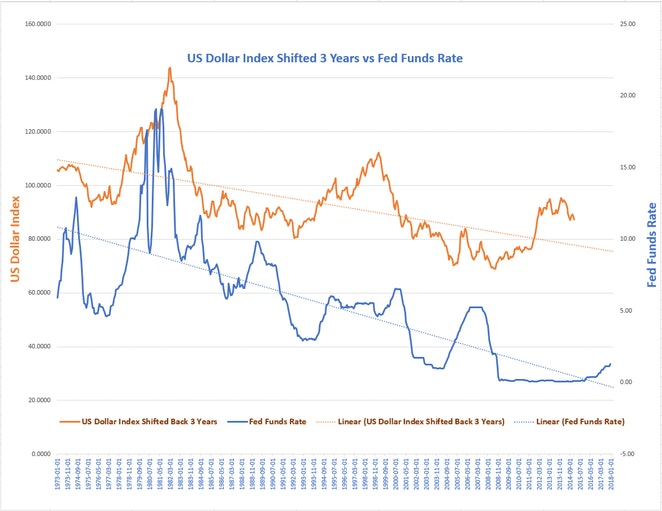People have been predicting a crash in the US dollar for something like forever. Let’s investigate another crash thesis.
ZeroHedge reports the “World’s Most Bearish Hedge Fund” has a “Stunning” Theory What Happens Next to the Dollar.
Bear in mind the views that follow are not that of ZeroHedge but rather that of Horseman Global CIO Russell Clark who went 100% short in 2016 with negative results.
Clark did make money in 2017, an impressive result given the performance of the major indexes.
Clark’s Theory
- It is very easy to get bearish on bonds. With Chinese growth improving, and commodity prices rising, inflationary pressure is building. Furthermore, Chinese bonds currently offer 4%, substantially higher than developed market bonds. In addition, in a break with the Japanese experience of QE, the Federal Reserve has managed 5 interest rate increases, rather than only the one or two that Japan has been able to achieve since the bursting of the bubble. The refrain that I have heard these days is that QE works, and the US will be able to easily exit QE policies, followed by the ECB and the BOJ, and that bonds are a sell.
- The big increase in QE from the ECB and the BOJ that we saw in 2016, has seen capital move from Japan and Europe to the US. This has meant that even as the US has raised rates, credit conditions have remained very favourable. This combined with a recovery in China has created an extremely favourable market for all assets in 2017. But what does it mean for 2018?
- Well, if the QE model still holds, then the capital flows from Europe and Japan to the US are beginning to slow and even reverse. The implications of this is that the strategy is to be bearish US dollars and bearish on US corporate credit. It also implies being bearish on European and Japanese banks, and buying of bunds and JGBs, however this remains to be seen.
- The worst-case scenario would be profound dollar weakness forcing the Federal Reserve to increase interest rates much more quickly than expected. Dollar weakness would cause Japanese and European exporters to suffer, forcing money into JGBs and bunds. This would be like the capital flight market in the US we saw in the late ‘70s. For reference, Swiss bonds yielded only 2% in the late 1970s, even as US rates went to near 20%.
In a nutshell, profound dollar weakness will cause the Fed to hike causing capital flight and huge rate hikes.
Let’s explore the concept with pictures.
US Dollar Index vs. Fed Funds Rate

Long-Term Synopsis
- The US dollar index peaked in March of 1985 at 143.906. At that time, the Fed Funds Rate was 8.58%.
- In August of 2011 the US dollar index was 69.061. The Fed Funds Rate was 0.10%.
- The US dollar index dropped 52% while the Fed Funds Rate declined 8.48 percentage points.
Some might object that is too long a timeline to make a determination. We need something more “profound”.
OK point taken.
Short-Term Synopsis
- The US dollar index peaked in March of 1985 at 143.906. At that time, the Fed Funds Rate was 8.58%.
- Three years later, in April of 1988, the US dollar index declined to 87.994. The Fed Funds Rate declined to 6.87%.
- The US dollar index declined 38.85% in three years while the Fed Funds Rate declined 1.71 percentage points.
Cart Before the Horse
Perhaps that is still not “profound” enough.
Regardless, expecting the Fed to react to a falling dollar seems to put the cart before the horse. Let’s shift the timelines to make that idea a bit more clear.
US Dollar Index Shifted 3 Years vs. Fed Funds Rate

Explanation
To create the above chart I downloaded the Fred data from the first chart into Excel, then shifted the US dollar index back three years.
That is not a perfect correlation, but it’s far better than the first chart. There will never be a perfect correlation but the following general guidelines apply.
General Guidelines
- The Fed does not tend to react to a falling or rising dollar.
- Instead, the dollar reacts to anticipated moves by the Fed and other central banks.
- There may be leads or lags in any direction because it is not just the Fed in play.
- In addition to anticipated moves by the Fed, what the ECB is perceived to do is of huge significance. Interest rates decisions by China and Japan matter considerably less.
- Finally, there are flights of safety concerns, solvency concerns, and eurozone breakup concerns in play.
Sexy Predictions
Predicting a crash in nearly anything is sexy. People flock to such predictions, and bad predictions come and go, only to be embraced time and time again.
The US dollar index may crash. Yep, it might. But vs. what?
Please don’t tell me the dollar will crash vs Bitcoin. Bitcoin is too small to matter.
Besides, that “crash” if you wish to label it as such, has already occurred. Bitcoin is now highly likely to crash vs the dollar.
Crash vs. What Major Currency?
- The European banking system and Target2 system are insolvent.
- The Chinese banking system is insolvent.
- Chinese State Owned Enterprises (SOEs) are insolvent.
- It takes massive amounts of debt for China to grow. China has one of the world’s largest property bubbles.
- The US has a debt problem. But Japan’s and China’s are worse. The demographics in Europe, Japan, and China are also worse than in the US.
- The yen and Japan’s 20-year QE experiment are accidents waiting to happen.
Wile E. Coyote Moment
OK the US dollar “may” crash. But if you are predicting that, please tell us against what.
Lay out the case. Tell me where I am wrong regarding points 1-6 above.
Those predicting a US dollar crash float like the Wile E. Coyote in mid-air without a leg to stand on.
Gold in Play
The US dollar is not going to “crash” against the euro, the pound, the yen, or the yuan. Problems are similar if not far worse elsewhere.
Hyperinflation calls are absurd.
The US dollar could crash against gold and some believe will.
While I am not calling for a crash vs. gold, I would not be surprised in the least if gold went to $5,000 or higher.
One Recession From Crashing Rates
The irony in the dollar crash thesis is we are likely one recession away from crashing interest rates.
Meanwhile, please consider Mish Mailbag: Inflation-Deflation Debate – Bond Bears Still Wrong.
Also consider “You Bet Your Heinie” Bill Gross Needs a Fatter Crayon.
Just as happened in 2008 when oil soared over $140, people are coming out of the woodwork to proclaim massive inflation and dollar crashes.
Jan 22, 2018 01:14AM ET
Source: Investing.com

